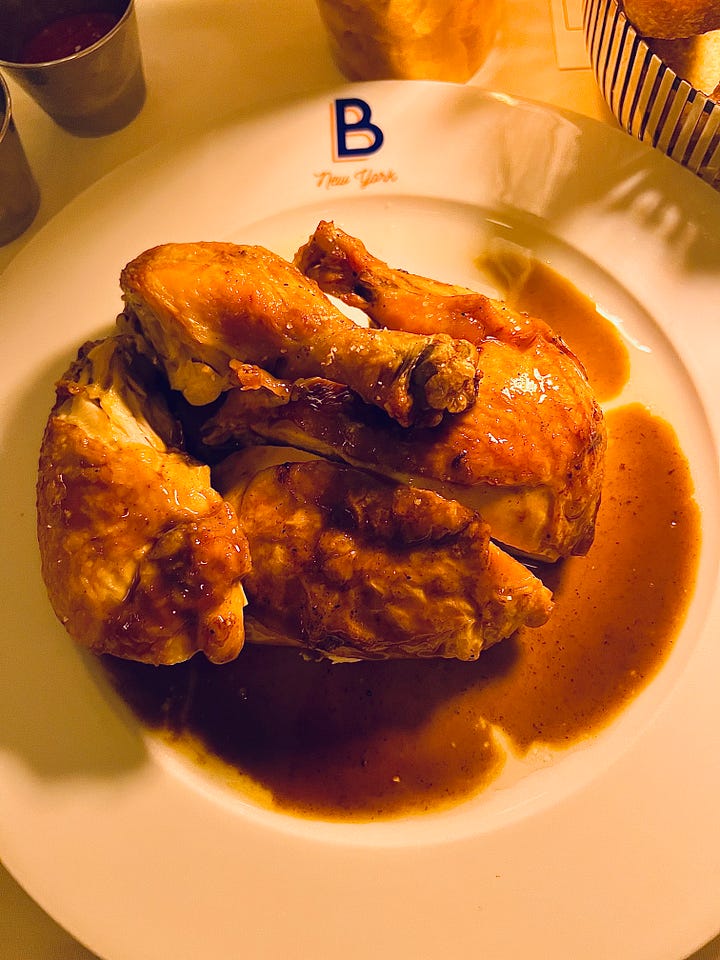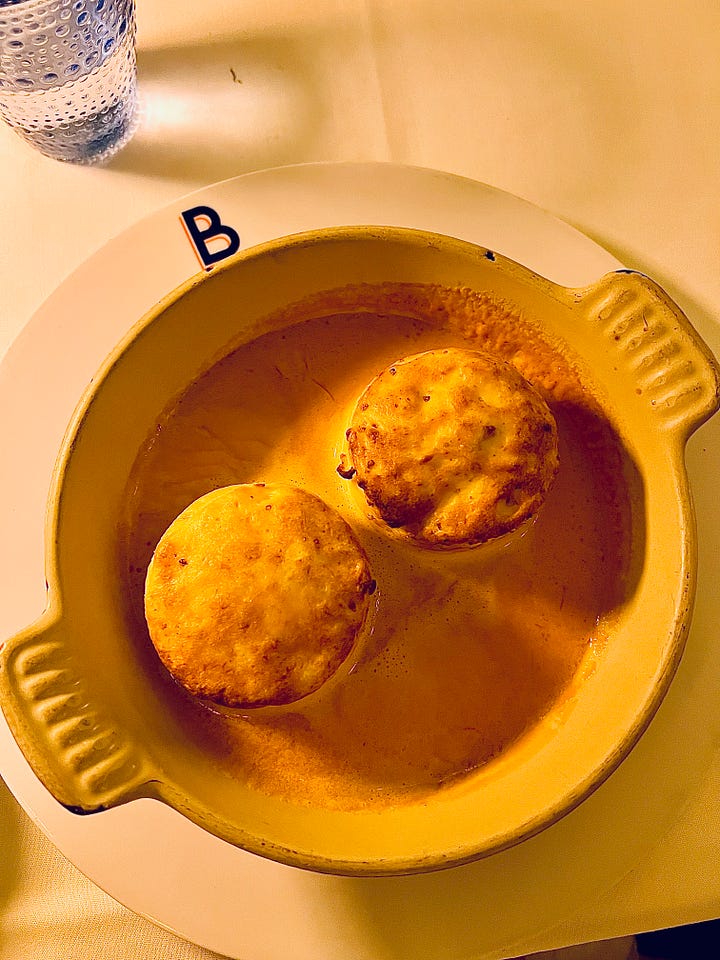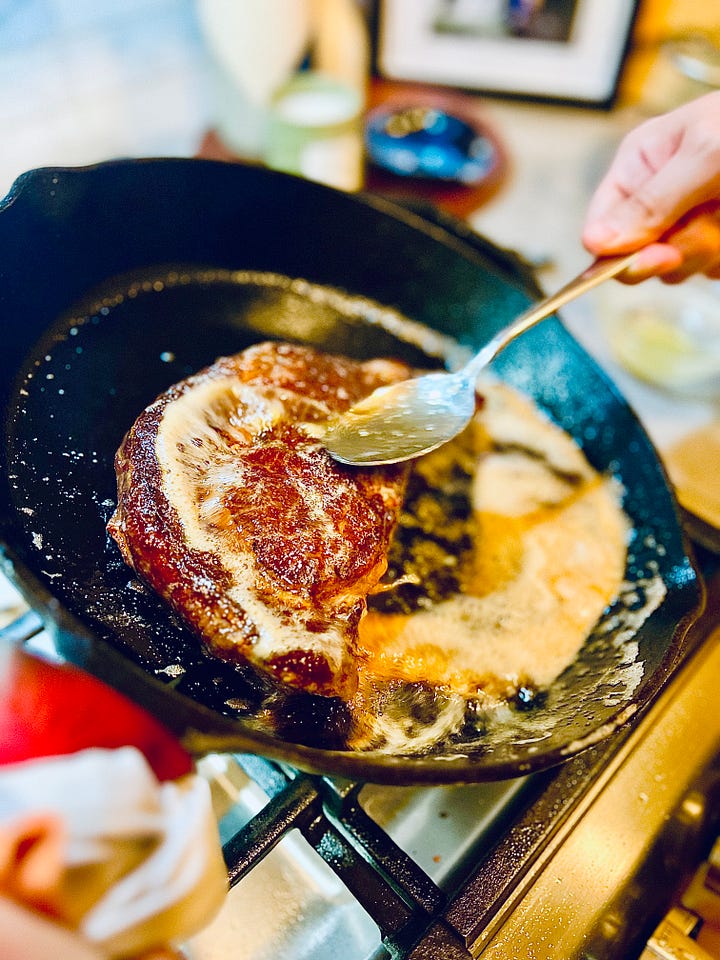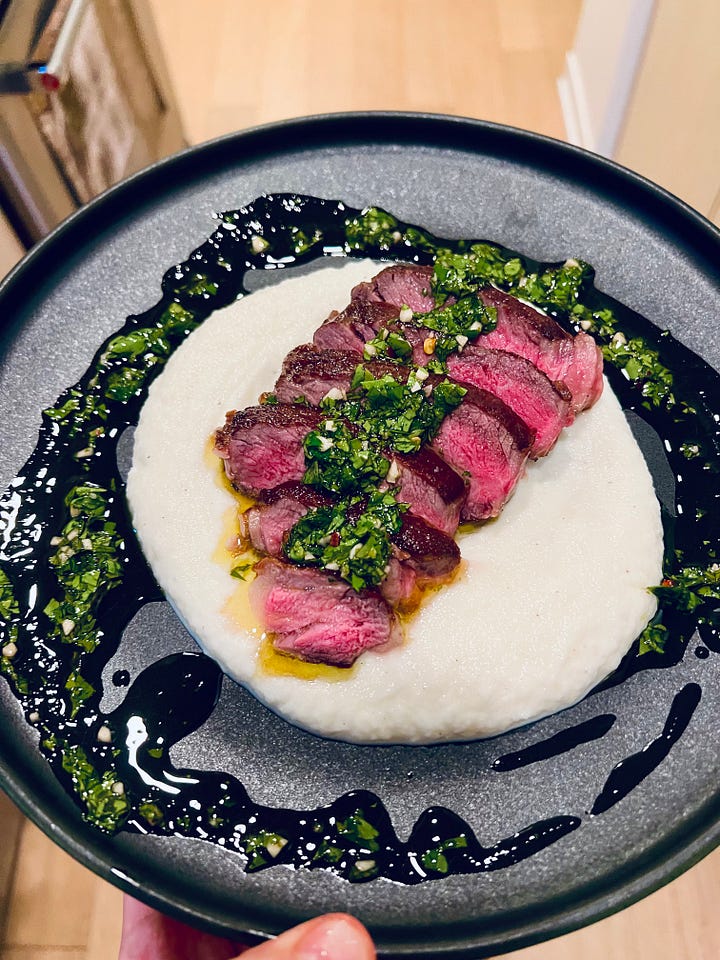🗽 What I’m Ordering
It somehow took me at least half a dozen trips to Benoit to realize that it is an Alain Ducasse restaurant, modeled after the original in Paris. Although I was completely oblivious to its famous founding chef, I’ve liked this French bistro for several years now. Becky and I met my dad there for Father’s Day.
🔪 What I’m Cooking
Every meat-eater should know how to cook a great steak at home. Season aggressively before drying it and tempering it. Then give each side a hard sear on a ripping hot pan, baste, and please, please let it rest before slicing. I served mine with classic chimichurri and some cauliflower purée.
✔️ Tip of the Week
Like with other recipes I’ve shared recently (chicken thighs, potatoes), the key to a great steak is creating the outside crust without overcooking the inside. Tempering your steak (bringing it down to room temperature before cooking) makes a world of difference. Throwing a steak in the pan five minutes after it was in the fridge is a classic home cook mistake.
👇 More Details Below
My faves at Benoit
My full pan-seared ribeye & chimichurri recipe
More steakhouse secrets for perfect chops
Benoit


Alain Ducasse is one of only two chefs to ever hold 21 Michelin stars (Joël Robuchon, 31). His New York iteration of this restaurant isn’t part of that list, unlike its sister establishments in Paris and Tokyo, but the bistro food still shines.
Naturally, it has a strong Poulet Rôti (roasted chicken) and Onion Soup Gratinée (don’t be the goof who asks for “French onion soup” at a French restaurant). I’d also recommend the Escargots, if you’re game to try — they’re really just a vehicle for delicious garlic butter. Most of all, I owe Benoit credit for introducing me to Quenelles (essentially fish cakes) in a crayfish bisque of sorts. They are so much better than my description makes them sound. Finish dinner with a super-light, super-fluffy Mousse au Chocolat.
Pan-Seared Ribeye with Chimichurri


Nothing satisfies quite like a great steak, and fortunately it’s totally possible to accomplish that at home. This chimichurri makes for a nice sidekick as the acid and fresh herbs cut through some of the richness of the meat. Here’s my full recipe.
1 ribeye steak, 1–1.25 lbs, about 1.5 inches thick
Salt & freshly ground black pepper
3 tbsp. neutral oil (e.g., canola or avocado oil)
4 tbsp. unsalted butter
2 garlic cloves, smashed
A few sprigs of thyme and/or rosemary
1/2 cup fresh parsley, finely chopped
1 garlic clove, very finely chopped
4.5 tsp. red wine vinegar
1/4 cup olive oil
Pinch of red pepper flakes
Serves 2
Pat steak dry and season aggressively with salt and pepper. If you have time, leave uncovered in fridge for hours or overnight; then pat dry again.
Let steak come to room temperature for about 30-60 minutes before cooking.
Meanwhile, prepare basting butter: heat butter, smashed garlic, and herbs in a saucepan over low heat until butter is infused with flavors and is fragrant. Discard garlic and herbs and set butter aside.
Prepare chimichurri: combine parsley, chopped garlic, vinegar, olive oil, and red pepper flakes. Season to taste with salt.
Once steak has tempered, heat oil in cast iron pan over high heat until ripping hot. Add steak and weigh down with another pot (such as the one used for infusing butter).
Sear steak for 3-4 minutes on first side until a deep brown crust forms.
Flip, re-place pot on top of steak, and sear for another 3-4 minutes.
Turn off heat, add infused butter to pan, and baste for 1-2 minutes.
Remove steak from hot pan and let it rest for 10 minutes.
Slice steak against the grain and spoon chimichurri on top to serve.
Notes:
I learned the butter infusion trick from a chef friend, and it works well for me, but it isn’t necessary. Feel free to simply add your butter, garlic, and herbs to the steak pan when it’s time to baste.
Don’t be afraid to season your steak aggressively with salt and coarse pepper. As the hefty protein that it is, steak can really handle a lot, and under-seasoned steak is not so pleasant.
High Steaks
Here are some more ways your favorite steakhouse achieves that crispy crust and perfectly-cooked center.
Dry-Aging / Dry-Brining: Amazingly, you can do this at home. Like I mentioned with my recent chicken thigh recipe, leaving your steak uncovered in the fridge overnight or even for a few hours will draw moisture from the outermost layer, which will help you land that perfect crust. The day before you cook, pat your steak dry with paper towel, hit it with a good dose of salt, and leave it in the fridge. Then, pat dry again before you actually start to cook it.
Tempering: As discussed above, under no circumstances should you be putting a cold steak in a pan. It is critical (and completely safe) to let your steak come down to room temperature before cooking it.
Basting: When you are nearly done cooking, get some extra fat in the pan and spoon it over your steak for maximum juiciness.
Resting: Maybe most crucial of all. I cringe when I see someone work hard on a perfect steak and then slice it immediately. The juice runs out, and you end up with a dry, grainy steak. Gross. A good rule of thumb is to let your steak rest for at least as long as you cooked it (a surprisingly long time!). This will allow the muscle fibers to relax and reabsorb the juices. Remember that your steak will continue to cook a bit as it rests, so pull it off the pan a touch sooner than you think.




